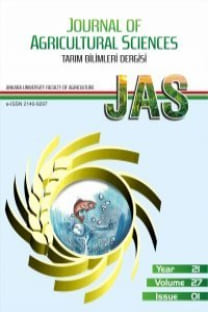Üstel dağılımlı populasyonlardan alınan örneklerde tek yönlü varyans analizi yöntemi ile bazı yaklaşım testlerinin güç değeri bakımından karşılaştırılması
Comparison the power of the test of one-way ANOVA method and some approximation tests for the samples drawn from the exponential distributed population
___
- Alexander, R. A. and D. M. Govern, 1994. A new and simpler approximation for Anova under variance heterogeneity. J. of Edu. Stat., 19 (2) 91-101. Anonymous, 1994. IMSL MATH / LIBRARY FORTRAN subroutines for mathematical applications. Vol: 1, 2, Visual Numerics Inc. USA. Edgington, E. S. 1974. A new tabulated of statistical procedures used in APA journals. Am. Psychologist, 29, 25-26. James, G. S. 1951. The comparison of several groups of observation when the ratios of the population vari a nces are known. Biometrika, 38, 324-329. Lı x, L. M, J. C. Keselman and H. J. Keselman, 1996. Consequences of assumption violations revised: A quantitative review of alternatives to the one-way analysis of variance F test. Review of Educational. Research, 66 (4) 579-619 Marascuilo, L. A. 1971. Statistical Methods for Beevioral Science Research. McGraw-Hill 578p. New York. Oshima, T. C. and J. Algina, 1992. Type I error for James's second-order test and Wilcox' Hm test under heteroscedasticity and non-normality. British J. of Mathematichal and Statistical Psychology, 45, 255-263. Sokal, R. R. and F. J. Rohlf, 1995. Bimetry, W. H. Freeman and Company. 887p., New York. Tomarken A. J. and R. C. Serlin, 1986. Comparison of anova alternatives under variance heterogeneity and specific noncentrality structures. Psycholoical Bulletin 99 (1) 90-99. Wilcox, R. R. 1989. Adjusting for unequal variances when the comparing mean in one- way and two-way fixed effect anova models. J. of Educational Statistics, 14 (3) 269-278 . Winer, B. J. 1991. Statistical Principles in Experimental Design, McGraw-Hill Company. 907p. New York.
- Yayın Aralığı: 4
- Yayıncı: Ankara Üniversitesi Basımevi
Türkiye' de Orta Anadolu Bölgesinde kavunlarda Verticillium solgunluğu
M. Demir KAYA, Muharrem KAYA, Cemalettin Y. ÇİFTÇİ
Müge KOSER, A. Murat TATAR, İlkay BARITCI, Nihat TEKEL, Gürsel DELLAL
Farklı mevsimlerde uygulanandeğişik aydınlatma programlarının broiler performansına etkileri
Mesut TÜRKOĞLU, Sedat AKTAN, Okan ELİBOL
Standart Traktörlerde Kuyruk Mili Gücünün Tahmini İçin Karşılaştırmalı Bir Model Çalışması
